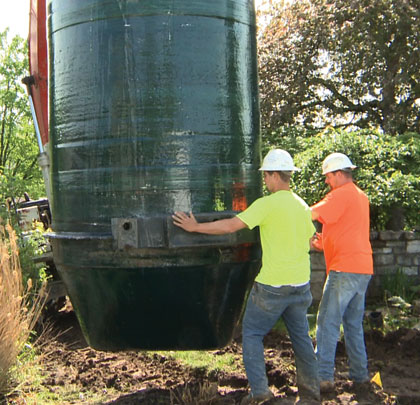Throughout his fourteen years with Valley Rural Utilities (VRU), Floyd Ogden has confronted numerous deficiencies with the aging wastewater collection system serving Hidden Lake, a lakeside residential development located in Dearborn County outside of Lawrenceville, Indiana. Recurring pump station failures and I and I have been among issues at the top of the list. He attributes the problems to the system’s age and deterioration, clog-prone pumps, shoddy original construction, and capacity shortfalls caused by higher density development than the collection system’s original design for two hundred homesites.
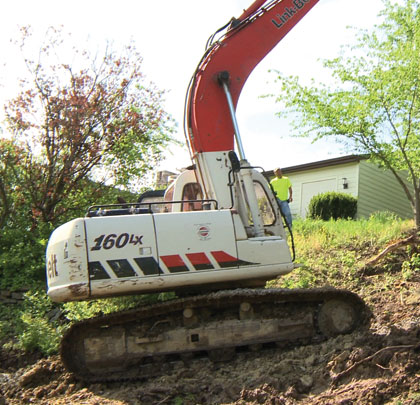
Fiberglass basin about to be inserted into hole adjacent to existing pump stations.
HIDDEN IN PLAIN SIGHT
“We experienced overflows and up to six pump outages a month that cost us at least $250 per incident,” Ogden recollects. “The failures drew customer complaints and were sapping our budgets until we recently qualified for a $13 million federal loan through the USDA Rural Development that will underwrite an extensive multi-phase improvement program. Among the numerous problems we identified in a preliminary engineering study were eight of our twelve duplex lift stations had reached the end of their life expectancy. Their replacement became a high priority.”
VRU acquired the Hidden Lake service area in 1995 from the homeowners association that had assumed control of the sewage system from the subdivision’s developer. The private utility serves a total of 1945 customers in a service area near the state line with Ohio and anticipates projected growth will add another 1000 connections.
The Hidden Lake infrastructure is defined by fifteen sections with 230,000 linear feet (70,104 meters) of line and 850 manholes that include twelve lift stations. The lines are predominantly 8-inch (203.2 millimeters) clay that feed into larger trunk lines, some as large as 15 inches (381 millimeters), and a one-million-gallon (3,785,410 liters) equalization basin that acts as a backstop for handling wet weather events. Treatment occurs downstream at the South Dearborn Regional District Wastewater Treatment Plant in Lawrenceburg, Indiana.
Replacing the 110 to 660 gallons per minute (6.94 to 41.64 liters per second) pump stations was complicated by their locations. Several of them are located 100 feet (30.48 meters) off the road, with steep topography, and unavoidable intrusions into customer homesites would be a necessity. Like most utility managers, Ogden needed access across legitimate easements with mature landscaping whose disruptions could spark an expected firestorm of customer protests. Completing the replacements as fast as possible while the existing stations remained active further shaped the project management plan.
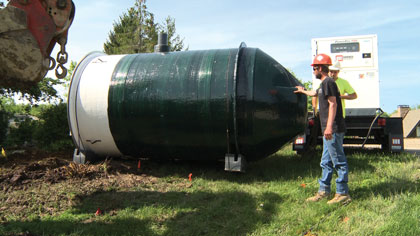
Basins have a sloped bottom to churn solids into the Flygt N pump.
AN INNOVATIVE SOLUTION
HREZO Engineering Inc., VRU’s consultants, officed in Greendale, IN worked with the utility to devise a more practical alternative than demolition and rebuilds of the eight precast concrete facilities. Instead, the amended operating plan called for the original precast concrete stations to have their pumps removed and the wetwells converted to junction basins that would continue to collect the sewage from their original service lines. The collected wastewater would then flow by gravity through a single discharge outlet into an adjacent, prefabricated lift station from where it would be pumped downstream for eventual treatment at the South Dearborn Regional Sewer District WWTP in Lawrenceburg. Preserving the original service connections at the precast stations kept the penetrations in the prefabricated fiberglass wetwells to single inlet and discharge outlets at each location.
The adjacent prefabricated wetwells are but half of a two-part lift station package designed specifically to complement the performance of a new generation of submersible—and uniquely clog-resistant pump. The combined package, manufactured by Flygt, a brand within Xylem Water Solutions, Inc., presented a remarkably simple and faster installation for the tandem replacements assuming the pumping mission. Following success with the two-part lift station and control panel at one installation, the utility had HREZO Engineering undertake engineering and design to apply the same units at the remaining stations.
The prefabricated TOPS units (The Optimal Pump Station) are each equipped with a recently introduced Flygt Adaptive N-Pump. The complete package, including control panels and a Flygt AquaView SCADA management software system, were procured directly from the manufacturer. The single source for the integrated system included the prefabricated wetwells, pumps, easy access split aluminum access covers, sealed wall penetrations, along with the required fittings, mounting hardware, cover, vent pipe, level and pump station controls. One station was also equipped with an optional Mix- Flush valve to clear the wetwell of any built up sludge. The installation contract was awarded to C & H Excavating, based in Milan, IN following competitive bids. The schedule calls for completing the installations by the end of this summer.
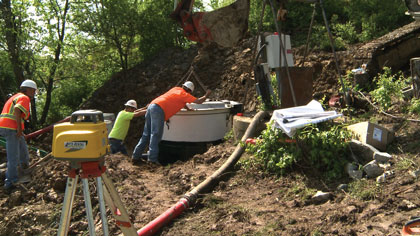
TOPS prefabricated station shown being set in place.
FEATURES COMPLEMENT PERFORMANCE
The TOPS concept also simplified procurement because a single source supplies the fiberglass wetwells, pumps, sealed wall penetrations, and required fittings, mounting hardware, vent pipe, level and pump station controls. The aluminum access cover utilizes an integral Safe-Hatch design, which provides fall through protection that completes the package.
The innovative, self-cleaning wetwell bottom directs solids and debris to the inlet of the Flygt Adaptive N Pumps where they can be pumped from the station. The combined design features optimize the fluid handling of a lift station, especially those facilities with high solids and debris in their flows. The twofold design features inherently eliminate “dead zones” where sludge can build up in non-agitated areas of traditional flat-bottom wetwells. One of the new stations also received a Mix-Flush Valve whose 15-second blast of recirculated wastewater flushes and helps remove settled solids at the bottom of the wetwell during startup of each pump cycle.
The hydraulics of the Adaptive N-Pump delivers another Flygt innovation in fluids handling to the utility equipment market. The self-cleaning impeller is the primary feature of the N-technology that delivers unrivaled clog-free performance. The Water Environment Federation recognized the Adaptive N-hydraulics by naming the enhanced N-Pump technology “The 2011 Most Innovative Product.”
The improved pump’s clog resistance benefits from an impeller designed to move axially upwards when encountering most bulky rags, cleaning and personal hygiene wipes, or the toughest other debris so it passes through smoothly.
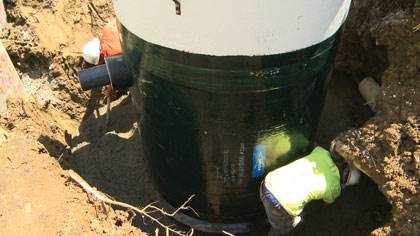
Crew spreading stable infill around the unit now in place and ready for connections.
The 6-foot (1.83 meters) diameter fiberglass stations are installed in fresh excavations, 14 to 16 feet (4.27 to 4.88 meters) deep, adjacent to the existing precast concrete stations that entered service in the 1970s. The added volume of the TOPS prefabricated wetwells provide the capacity increase to gain the needed efficiency and to handle the past growth in connections. Furthermore, the more clog-resistant Adaptive N-pumps are acclaimed for eliminating built up material on their impellers that induces drag and compromise energy efficiency.
“Our first station entered service two years ago and has used less than half the electricity of the old pumps,” Ogden says.
He expects the work at the eight stations to be completed later this year when he can turn his attention to other issues affecting the collection system. ■
_________________________________________________________________________
ABOUT THE AUTHOR
Steve London is president of Steven London Associates, Lansdale, Pennsylvania. Steve has extensive background as a writer and editor specific to municipal water treatment technologies. For the past eighteen years, the company has been involved in the development of application stories that highlight various solutions for water management professionals. He can be contacted at slondon2@verizon.net or 215.361.3630.
_________________________________________________________________________
MODERN PUMPING TODAY, September 2013
Did you enjoy this article?
Subscribe to the FREE Digital Edition of Modern Pumping Today Magazine!
![]()


